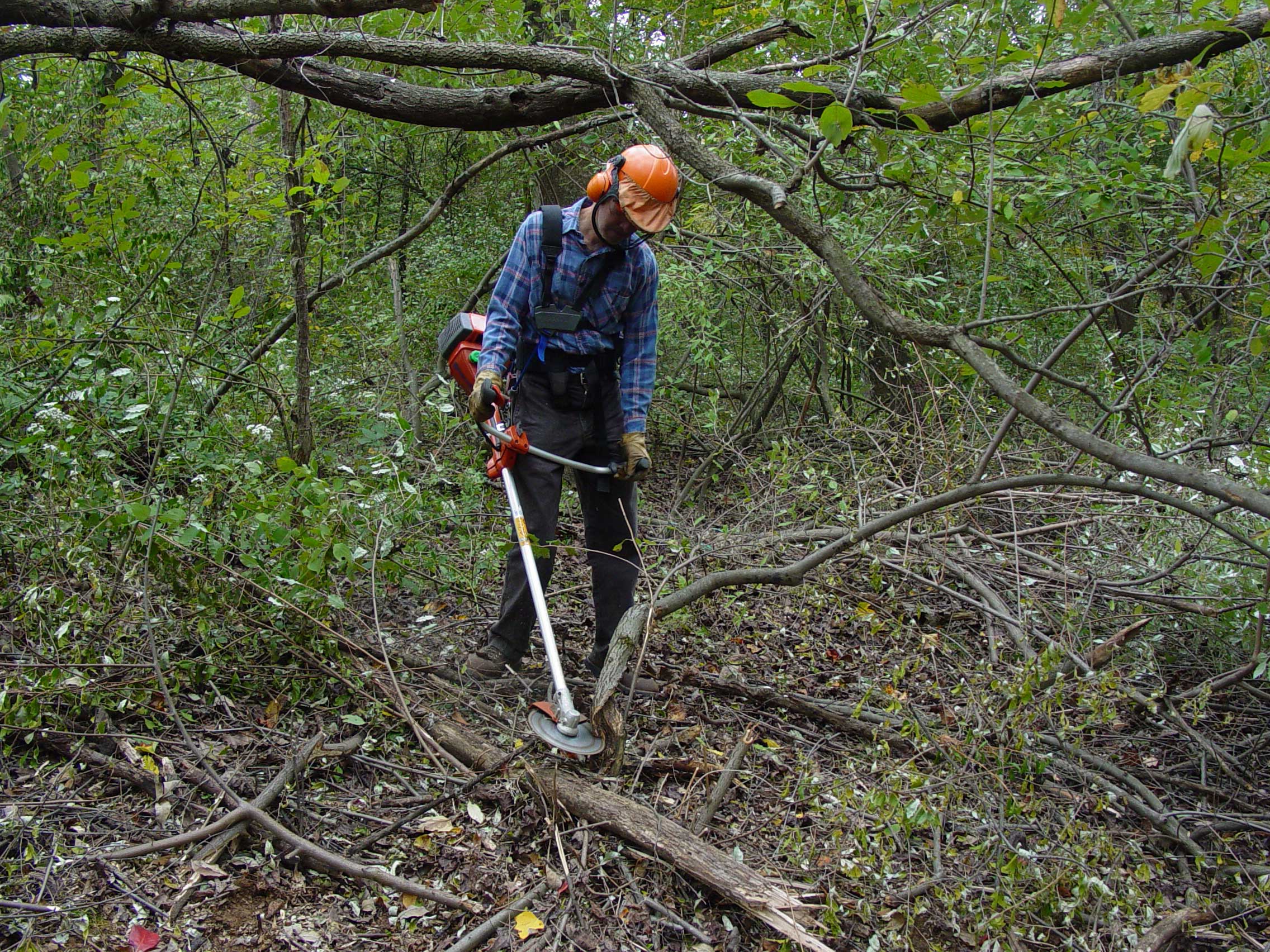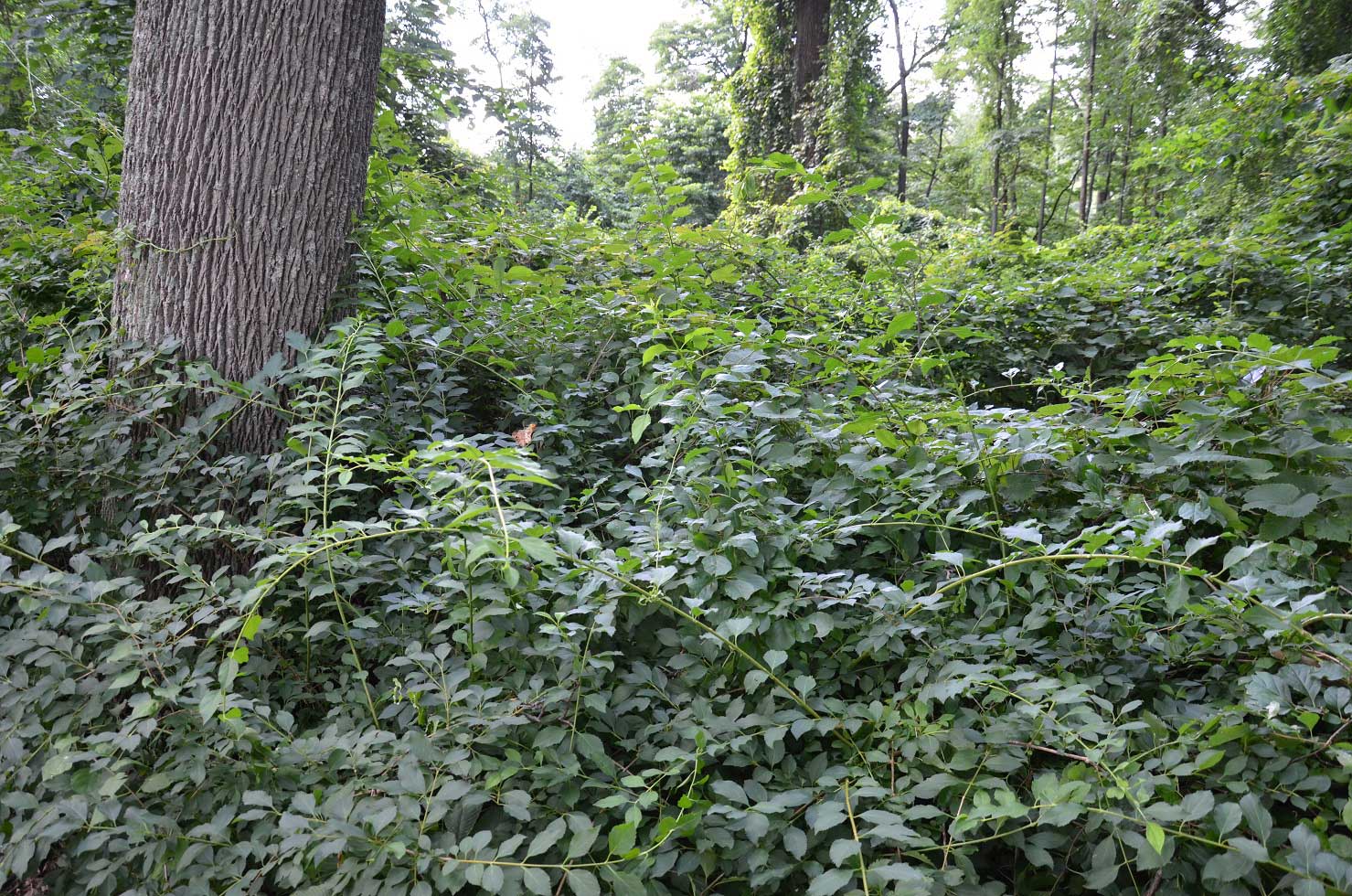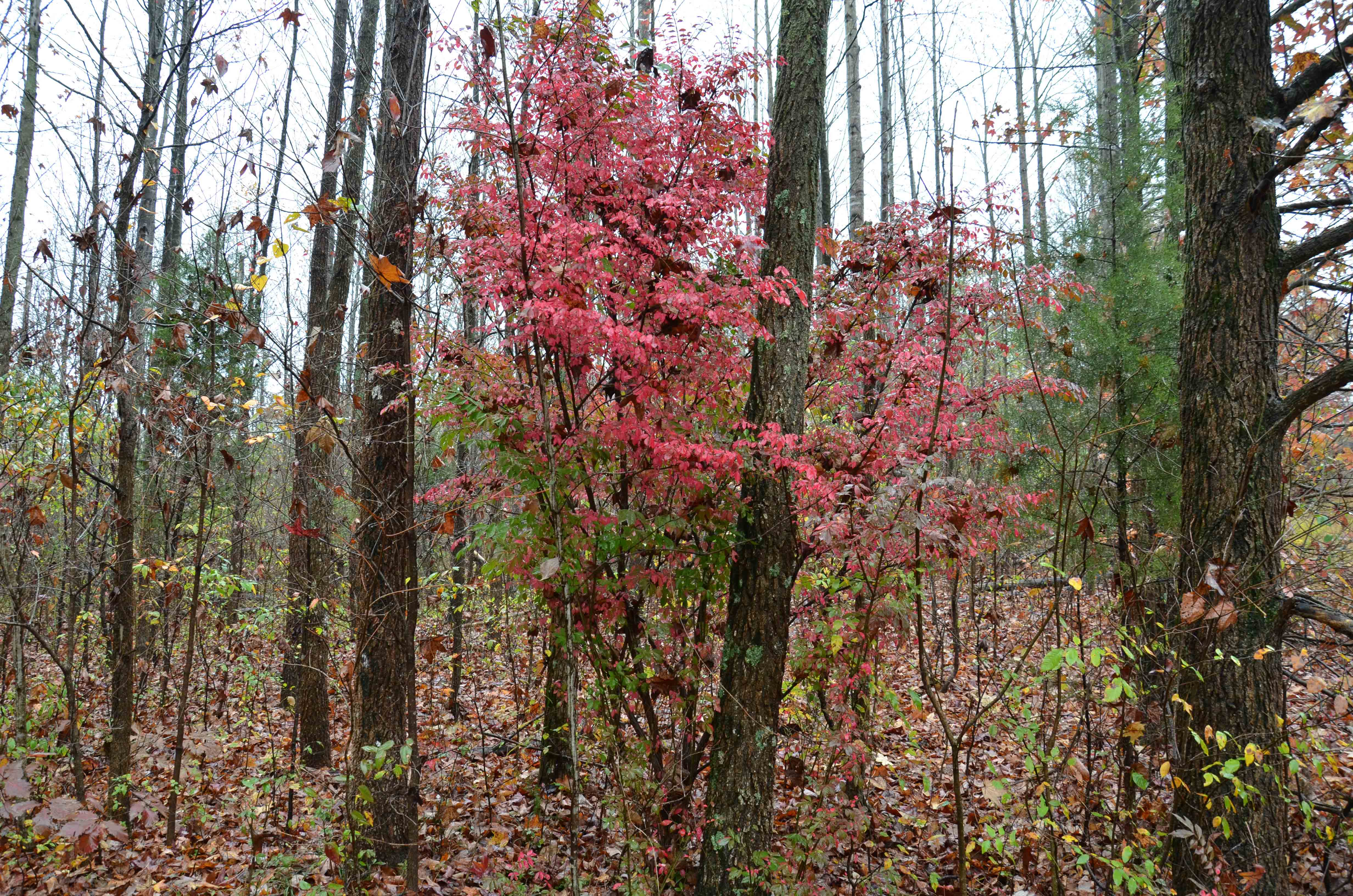Invasive Vegetation Control Costs
By Ron Rathfon
The three principles of invasive vegetation management listed in order of their priority are:
1. Prevention
2. Early Detection, Rapid Response (EDRR)
3. Strategic control of existing infestations (establishing priorities based on
management objectives)
These priorities hold true regardless of the scale at which you are planning invasive species management – national, state, regional, county, or individual property. Incorporating prevention and EDRR best management practices into both long-term and day-to-day management planning and activities is the proverbial ounce that’s worth 12½ pounds or more of cure.
There are many variables influencing the cost of managing invasive species on your land, including the cost incurred by doing nothing. Invasive species cost, whether we choose to manage them or not. First, there is reduced timber productivity caused by competition for water, nutrients, and light. Asian bush honeysuckle growing in a hardwood forest understory has been shown to reduce tree stem growth by 58%. Numerous studies of a variety of invasive plants document the reduction and loss of tree regeneration and other native forest plants through direct competition and through alteration of soil chemistry and microbiota (bacteria and fungi). On a larger scale, the cost in terms of habitat alteration and loss for many species of wildlife is difficult to calculate. Loss of outdoor recreation value deprives us and future generations as more and more of our forestland becomes choked with dense invasive, tangled, and often thorny brush.
Prevention
Invasive plant species prevention activities include cleaning shoes/boots and clothing and equipment to keep from transporting seeds to new non-infested sites. This costs you about five minutes plus the cost of an inexpensive, stiff-bristled scrub brush or a boot brush stand. Cleaning an ATV or a truck may take 10 – 15 minutes. The hard part of these simple measures is ingraining it into your psyche so you remember to do it when needed.
Cleaning logging equipment, on the other hand, is an expensive proposition. If you don’t already have species like Japanese stilt grass, Japanese chaff flower, or garlic mustard invading your property and you are planning to harvest timber, requiring the logger to clean their equipment prior to their arrival is the best way to insure no new infestations will get started. Since this is a relatively new idea and is not a part of current logging best management practices, you should include this stipulation in the timber sale notice and in the timber sale contract. Cleaning logging equipment may take the better part of a day for larger companies with more equipment. With travel time, lost production time, and actual cleaning time, the cost can run into thousands of dollars. The landowner can expect to pay for this in a lower price paid for their timber to reflect these costs. Is it worth this cost? I would argue yes, especially if an infestation gets started and is ignored for years until it has overrun large areas of your property. It could cost several hundred dollars per acre over five to seven years to eradicate these species, not to mention the costs associated with ecological damage. Brush saws can be used to safely and efficiently clear infestations of large invasive brush species. Applying an appropriate herbicide to the cut stump shortly after cutting will prevent sprouting.
Brush saws can be used to safely and efficiently clear infestations of large invasive brush species. Applying an appropriate herbicide to the cut stump shortly after cutting will prevent sprouting.
One other common-sense prevention best practice is to choose native plant species for conservation plantings and landscaping rather than invasive species. In many cases, native alternative plants cost little to nothing more than their popular invasive counterparts. On the other hand, popular invasive trees, shrubs, and ornamental grasses such as the ornamental Callery pears (Bradford, Cleveland and other cultivars), burning bush, winter creeper, and Chinese silver grass (Miscanthus), are quickly becoming an ecological storm across Indiana’s landscape. When purchasing landscaping plants, check the list of invasive plants maintained by Indiana Invasive Species Council website to be sure what you are thinking of buying isn’t on that list (www.entm.purdue.edu/iisc/invasiveplants.php).
EDRR
Early detection, rapid response involves inspecting or monitoring your property on a regular basis to look for invasive plants trying to get established. Where newly establishing invasive plants are found, quickly destroy them before they begin to spread.
Healthy, undisturbed forests and native plant communities are quite resistant to invasive plant encroachment. Disturbance of those communities creates the opportunity for invasive plants to get established. Road construction, logging, fire, storm damage, insect and disease mortality are examples of disturbance in the forest that can allow invasive plants to get a toehold. Edge habitat such as at the interface of field and forest or roadsides are areas vulnerable to invasive plant establishment. Monitoring should therefore focus on these areas where probability for invasion are much higher. Oriental bittersweet taking over this forest understory and climbing into canopy trees. Note the large, mature ash tree that will soon be dead from emerald ash borer. No tree seedlings will be able to emerge from the bittersweet.
Oriental bittersweet taking over this forest understory and climbing into canopy trees. Note the large, mature ash tree that will soon be dead from emerald ash borer. No tree seedlings will be able to emerge from the bittersweet.
As an example, for several years following logging, you should focus your EDRR activities on log yards, skid trails, and haul roads. Depending on the invasive species found and its seed dormancy in the soil seed bank, monitoring and control efforts should last four to eight years (assuming you did not follow the prevention recommendations described above). The initial cost of monitoring is the time it takes you to walk or ride those disturbed areas of your woods. Even if you do not find any invasive plants in the initial year following the disturbance, it is a good idea to check it again later that year or the following year, in case you missed something the first time. The two most likely species to be carried on logging equipment or by human foot or ATV traffic are garlic mustard and Japanese stilt grass. Both species’ seeds are very long-lived in the soil seed bank, continuing to germinate up to seven or more years after being deposited. Unfortunately, these two have very different growth habits from each other. Garlic mustard is a biennial and is not very noticeable until the second year following disturbance when a 2 – 4 ft. flower stalk emerges in late April through May. By early to mid-June seed pods are maturing, and by late June seed pods are opening and dispersing thousands of tiny seeds. The stalks quickly die and turn brown, becoming unnoticeable again as other vegetation emerges. Japanese stiltgrass does not emerge from surrounding vegetation and become noticeable until July. Seed develops in September and matures and disperses in late-September through October. Thus, following logging, monitoring needs to occur in both spring and mid- to late summer, over multiple years, to detect these two likely invaders. Incorporating early detection – rapid response (EDRR) in to your routine management would allow you to discover this single burning bush found along the edge of your woods and control it before it has a chance to spread.
Incorporating early detection – rapid response (EDRR) in to your routine management would allow you to discover this single burning bush found along the edge of your woods and control it before it has a chance to spread.
Another place to monitor for invasive plant establishment several years following logging or other disturbance is where gaps in the forest canopy have been made, particularly if Asian bush honeysuckle, Japanese honeysuckle, or autumn olive are growing nearby. Many birds feed on their berries then perch on tree limbs at the edge of canopy gaps within the interior of the forest, as well as along forest edges, where seed is dispersed through their droppings. Thus, these relatively shade-tolerant invaders get a foot-hold in the interior, and over the course of a decade or two, will spread throughout the forest.
So what does all this EDRR monitoring cost? If there are few invasive plants, your cost is your time to walk or ride over the priority areas of your property plus a minimal amount of time and herbicide needed to dispatch the invaders. More intensive monitoring will be needed in the first three to four years following disturbance, with diminishing monitoring needed as time goes on. A low intensity inspection focusing on disturbed areas may cost 5 - 15 minutes per acre, on average, conducted once per year. If significant numbers of individuals or patches of invasive plants are found, inspection becomes more intensive, takes more time, and control costs increase proportionally.
Examples of EDRR costs are found in two forest tracts located on the Southern Indiana Purdue Agricultural Center (SIPAC) in Dubois County, Indiana. Six years after logging and trail maintenance occurred in a 34 acre tract called Woods F, Japanese stilt grass was found in 2008 along skid trails in scattered patches ranging from a few plants to 600 ft 2 in size. Beginning in 2009 and continuing annually through 2015, trails were inspected and spot-sprayed annually for stilt grass. It took an average of 3¼ hours per year to ride and walk the 1.1 miles of trail and spray stilt grass using a small tractor with mounted sprayer with both spray boom and handgun, plus a backpack sprayer. An annual average of 9.5 gallons of mixed herbicide were applied. Although the annual amount of time required to inspect and treat small patches remained fairly consistent from year-to-year, the amount of herbicide needed has diminished with time as the size of stilt grass patches have shrunk and disappeared entirely. Assuming that I value my labor at $20/hour, labor cost me $65/year. Herbicide cost was roughly $6.20/year. Over the seven years, this EDRR effort on a very persistent invasive weed on 34 acres cost $497. We will continue to monitor for stilt grass in Woods F in 2016, expecting to find very little.
In the second tract, Woods P, stilt grass was found along its 0.7 mile of trail following trail construction and maintenance. The number and size of stilt grass patches were significantly smaller than in Woods F, ranging from a few plants to 300 ft2 in size. Annual time required to inspect and treat was 37 minutes with an average annual herbicide application of 1.2 gallons of mixed spray. Spray volumes ranged from 4 gallons in the first year to 1 quart in 2015. Using the same assumptions as for Woods F, labor cost $12.30/year and herbicide $1.00/year. Total cost over the seven years was $93.
Strategic Control of Existing Infestations
Because the cost of treating dense stands of invasive brush can be very high, in some cases exceeding $1,000/acre, landowners with limited resources need to think strategically about their management. This means working with a forester and other natural resource professionals to determine their goals and priorities first. Then they can develop a common-sense management plan that incorporates the management of invasive species that fits their budget. These professionals can also help landowners access government assistance available for invasive species management. Costs for managing well-established infestations of invasive vegetation are highly variable and are influenced by:
• species needing controlled (single or mixed)
• vegetation structure (size distribution and density)
• terrain
• access
• equipment available
• treatment methods and type of herbicide(s)
• skill/experience of labor
• labor cost (DIY, hire own labor, contract)
In a well-stocked hardwood forest in west-central Indiana, Asian bush honeysuckle dominated the forest understory. Bush honeysuckle stocking ranged from relatively light (230 shrubs under 4.5 ft. in height, no shrubs over 4.5 ft.) to very heavy stocking (2,500 shrubs under 4.5 ft., 2200 over 4.5 ft.). Using a backpack sprayer, labor ranged from 2.4 hours/acre in the lightly stocked stand to 10 hours/acre in the heavily stocked stand. Mixed herbicide application rates ranged from 9 gal/acre to 45 gal/acre in the respective stands. Cost for the lightly stocked stand was $48/acre for labor (assuming $20/hr.) and $10/acre for herbicide (glyphosate at $20/gal), or a total of $58/acre. For the heavily stocked stand, labor cost $200/acre and herbicide $41/acre, for a total of $241/acre.
You can plug in your own labor rates and herbicide cost. Keep in mind that if you hire a contractor, the per acre rates may be substantially higher. You will be paying for much more than actual labor, herbicide, and saw gas. You will be buying their expertise, acquired through training and over years of experience. They also have transportation costs, travel, equipment depreciation and maintenance, and overhead costs to include insurance, licensing, maintaining an office, book keeping, and meeting the requirements of government regulations, to name a few.
These are examples of first year costs. Since even the best efforts at control will never achieve 100 percent eradication in the first treatment, follow-up treatment will likely be needed. This is what I call the mop-up phase where only scattered surviving individuals and patches need to be treated at a much lower cost than the initial treatment. Without doing this follow-up treatment, the surviving invasive plants will, over time, reoccupy the area you worked so hard to reclaim.
Additional Resources
Invasive Species Council, BMP Top “Ten” List, www.entm.purdue.edu/iisc/bmps.php
Indiana Invasive Plant List, www.entm.purdue.edu/iisc/invasiveplants.php
Invasive Plants in Indiana, Pretty. . .Awful! (brochure) www.nature.org/cs/groups/webcontent/@web/@indiana/documents/document/prd_256311.pdf
Landscape Alternatives for Invasive Plants of the Midwest www.nippersink.org/pdfs/MIPN%20LandscapeAlternatives2013.pdf
Ron Rathfon is an Extension Forester with Purdue University’s Department of Forestry and Natural Resources. He is stationed at the Southern Indiana Purdue Agricultural Center (SIPAC) in Dubois County.
